Before the FIG created its World Cup circuit and before the American Cup came into existence, the U.S. tried to organize an annual World Cup.
On Saturday, April 26, 1969, gymnasts from Canada, Finland, Japan, Yugoslavia, and the United States gathered in Long Beach, California for the World Cup.
Here’s more information about the event.
Quick Links: Results | Photos | Competition Footage
No Surprise: The Soviet Union turned down the invitation to participate.
Surprise: Nakayama attended the meet
In the March 1969 issue of Modern Gymnast, the magazine’s editor, Glenn Sundby, wrote a column about the event. He suspected that politics were at play when the Soviet Union turned down the invitation.
On April 26th, 1969 at the Long Beach Arena the 1st ANNUAL USGF INVITATIONAL WORLD CUP will take place. Several Olympic Gold Medal Winners and top AA performers have already accepted our invitation and will be on hand for the competition … NAKAYAMA and KENMOTSU from Japan … CERAR from Yugoslavia … NISSENEN … from Finland … and we are still awaiting answers from several other top Olympic competitors (men and women) from around the World. We had hoped Caslovaska would be able to come, but as you know she got herself married while in Mexico and is now knitting baby clothes for an expected arrival about June or July. Mr. and Mrs. Voronin and Diamidov and Kuchinskaya from the USSR were also invited but we received word that they were too busy getting ready for the European Championships to be held the end of May and could not take time out from their training for our “World Cup”. Since the European Championships only accept two gymnasts from each country and we indicated we would accept top alternates from the USSR, it is your editor’s opinion it was more of a political position than a training factor .. .and this is too bad because how else can countries get to know and understand each other better than in an athletic event as wonderful as a GYMNASTIC WORLD INVITATIONAL? I am very sorry, but perhaps by the time next year rolls around and the SUCCESS OF THE 1ST WORLD CUP echoes around the globe we will have more top world Gymnasts asking to be invited to the 2ND USGF WORLD CUP IN 1970 … See you in LONG BEACH.
Spoiler alert: There would not be a second USGF World Cup in 1970, but there would be one in 1971, which Cathy Rigby won again.
Reminder #1: At the time, the United States Gymnastics Federation (USGF) still was trying to wrest control from the AAU and be recognized by the FIG as the sole gymnastics federation in the United States.
Reminder #2: In the 1960s, gymnasts could not accept prize money and still compete at the Olympics, so there wasn’t any financial incentive to attend this meet.
Reminder #3: Nakayama was one of the biggest names in gymnastics at the time. In Dortmund in 1966, he won team gold, as well as floor and high bar gold. At the Olympics in 1968, he won four gold medals: team, rings, parallel bars, and high bar. So, it was a big deal that he attended a meet organized by the USGF.
Results
Men’s Results
| Gymnast | Country | FX | PH | SR | VT | PB | HB | Total |
| 1. Nakayama Akinori | JPN | 9.55 | 9.50 | 9.40 | 9.45 | 9.65 | 9.80 | 57.35 |
| 2. Kenmotsu Eizo | JPN | 9.60 | 9.30 | 9.45 | 9.35 | 9.65 | 9.60 | 56.95 |
| 3. Cerar, Miroslav | YUG | 9.10 | 9.20 | 8.95 | 9.05 | 9.25 | 9.50 | 55.05 |
| 4. Nissinen, Mauno | FIN | 8.85 | 8.75 | 8.80 | 9.05 | 9.30 | 9.20 | 53.95 |
| 5. Emery, Bob | USA | 8.70 | 8.60 | 9.15 | 9.15 | 8.75 | 9.00 | 53.35 |
| 6. Thor, Dave | USA | 8.80 | 9.30 | 8.10 | 9.05 | 7.15 | 9.25 | 51.65 |
Women’s Results
| Gymnast | Country | VT | UB | BB | FX | Total |
| 1. Rigby, Cathy | USA | 8.95 | 9.55 | 9.55 | 9.40 | 37.45 |
| 2. Oda Chieko | JPN | 8.75 | 9.50 | 9.20 | 9.60 | 37.25 |
| 3. Tanac, Joyce | USA | 9.20 | 9.00 | 9.10 | 8.95 | 36.25 |
| 4. Šljepica, Nataša | YUG | 8.75 | 8.85 | 9.05 | 9.20 | 35.85 |
| 5. Diachun, Jennifer | CAN | 9.15 | 8.85 | 7.90 | 9.10 | 35.00 |
| 6. McDonnell, Teresa | CAN | 8.85 | 7.80 | 8.50 | 8.70 | 33.85 |
Here’s how the Japanese newspaper The Yomiuri described the event:
Japanese Gymnasts Show ‘Em The Whys and Hows
Gymnastics specialists abound the US — athletes who can look great on the rings but don’t know a side horse from a long horse.
So, in typical fashion Saturday night, two Japanese all-around performers, showed a gasping crowd at Long Beach State College why other countries don’t have specialists — why they have men who can do all six events well.
Akinori Nakayama scored 57.35 points out of a possible 60 in the six all-around events to win the US Gymnastics Federation’s World Cup. His best performance was a 9.80 score on high bar and his worst score was 9.40 on the side horse.
Countryman Eizo Kenmotsu scored 56.95 and third was Yugoslavia’s Miroslav Cerar, 55.05.
Mauno Nissinen of Finland and the University of Washington was fourth with 53.95. The only two Americans in the field of six, Bob Emery of Penn State and Dave Thor of Michigan State, had 53.35 and 51.965 [sic] respectively.
Pretty and petite 16-year old Cathy Rigby, a local favorite from Long Beach, captured the women’s title with a total of 37.45, just .2 ahead of Chieko Oda of Japan.
Third was steady Joyce Tanac of Seattle, Washington, 36.25 with Natasha Sljepica fourth at 35.85.
Jennifer Diachuin [sic] and Teresa McDonnel [sic] of Canada were fifth and sixth.
The Yomiuri, April 30, 1969
Photos
Photos from Madamoiselle Gymnast (May/June 1969) and Modern Gymnast (June/July 1969)
Competition Footage
Kenmotsu on FX
At the 1967 USSR Cup, we watched as the gymnasts struggled with double fulls. Two years later, in 1969, Kenmotsu wasn’t just doing a double full; he was doing a double full in combination with a back handspring step-out.
Yamashitas Galore!
As you can see, almost every gymnast opted to do a Yamashita. It was a 10.0 vault. Why do more than you had to?
Stability on parallel bars
The very first gymnast on parallel bars did a jam on a single rail, and several people had to hold the uprights in place.
For information on the evolution of apparatus norms in men’s gymnastics, head over to this post.
Nissinen’s double back off parallel bars
At the 1968 Olympics, Nissinen and Laiho of Finland did double back dismounts. Here we can see Nissinen’s double back dismount.
Note: Laiho had performed the dismount at the 1966 Worlds, and Soviet gymnast Medvedev had done it at the 1967 USSR Cup.
Tanac on BB: Joyce Tanac’s one-armed handstand was exceptional. That skill on beam was rare in women’s gymnastics, and it wasn’t in the 1968 women’s Code of Points.
In fact, it was a skill more commonly associated with men’s gymnastics. In the 1968 men’s Code of Points, a one-armed handstand was rated a C on parallel bars (the hardest rating at the time), and during the 1960s, the skill was performed by some of the top men’s artistic gymnasts, including Mikhail Voronin and Tsurumi Shuji.
Šljepica on VT: In a world full of Yamashitas (a handspring with a pike during the second flight phase), it is refreshing to see a different vault.
Rigby on FX: In her autobiography, Soviet legend Larisa Latynina remarked:
To find my own style, to find myself in gymnastics — that was what I wanted the most during that year that separated us from Melbourne. Yes, I didn’t have to consider any of this seriously before: I had to master the necessary inventory of movements, to learn a lot of elements. And then… “Play in a way that I won’t see that you memorized it.” I really wanted to achieve this: the lightness, gracefulness, ease are for the spectator and all the hard stuff, all the rough work, sweat, tears and callused palms can stay in the training gym. Strength, dexterity, courage — there is no artistic gymnastics without them, but all of it has to be in one natural blend and not catch your eye, not stun you.
Latynina, “Balance“
In other words, Latynina didn’t just want her routines to look effortless; she wanted them to look like they hadn’t been memorized/overly rehearsed. She wanted to give the impression of spontaneity.
And you can see how Latynina’s influence rippled throughout the world. Rigby’s routine is striving for that sense of spontaneity. For example, at the 0:31 mark in the video above, you think that she’s about to tumble down the diagonal again, but then, she dances in a different direction — almost as if she changed her mind at the last second.
On Rigby’s FX Music: It’s interesting that she used a traditional Soviet song (Katyusha/Yablochko) for her floor music during the Cold War.
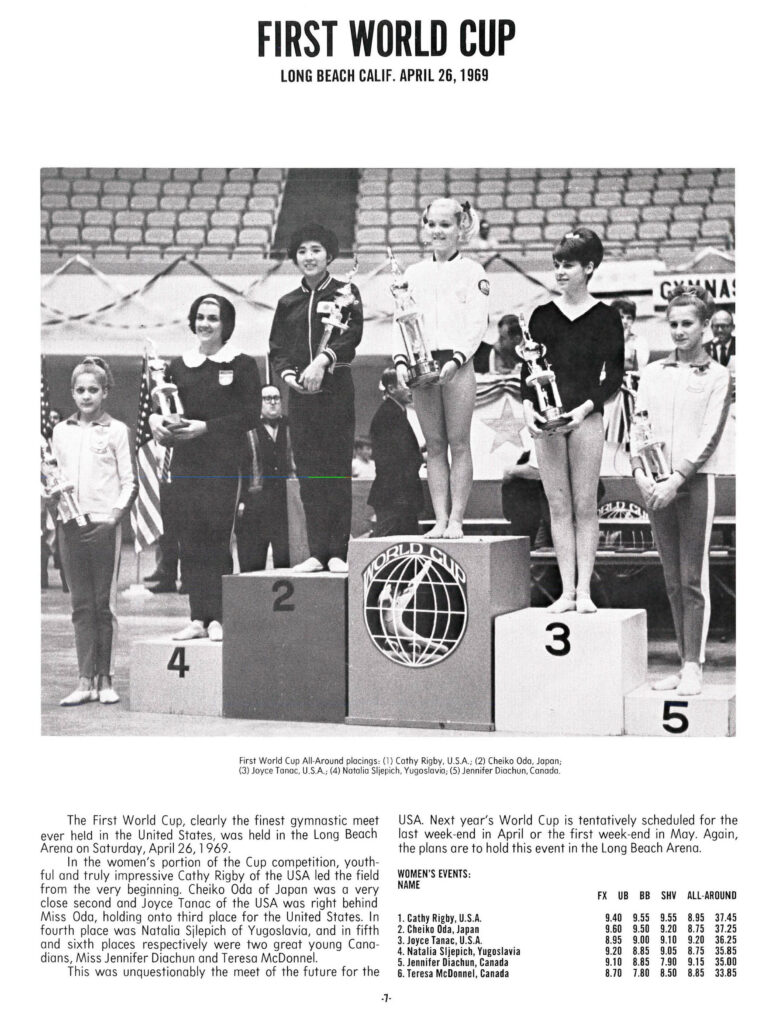
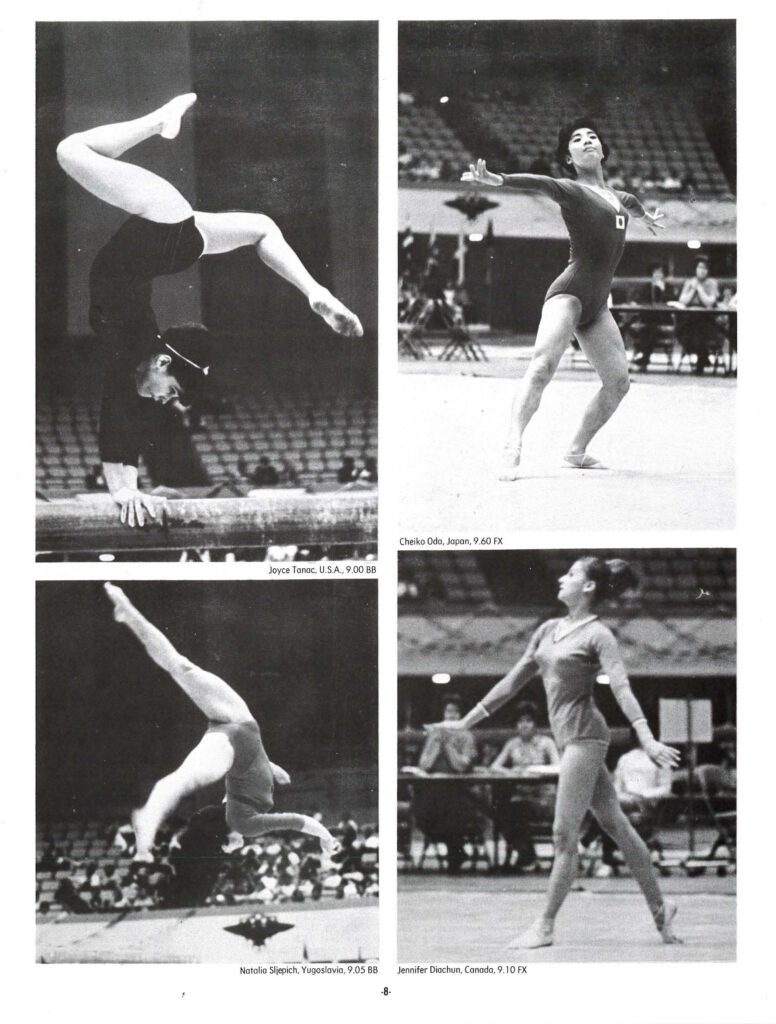
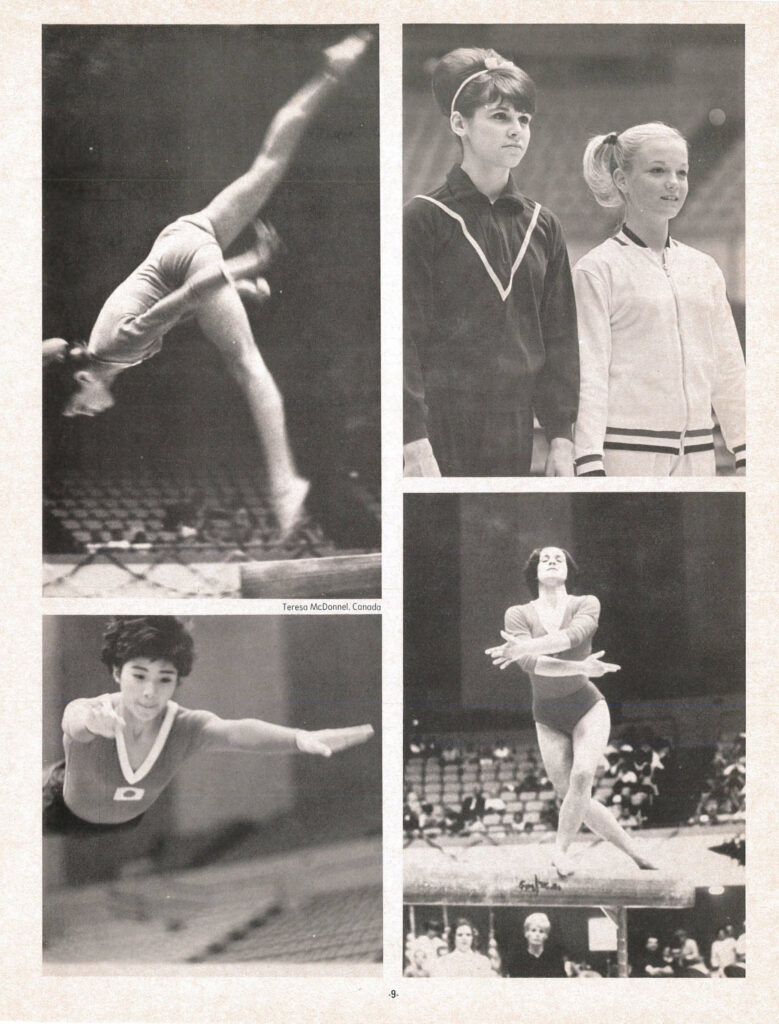
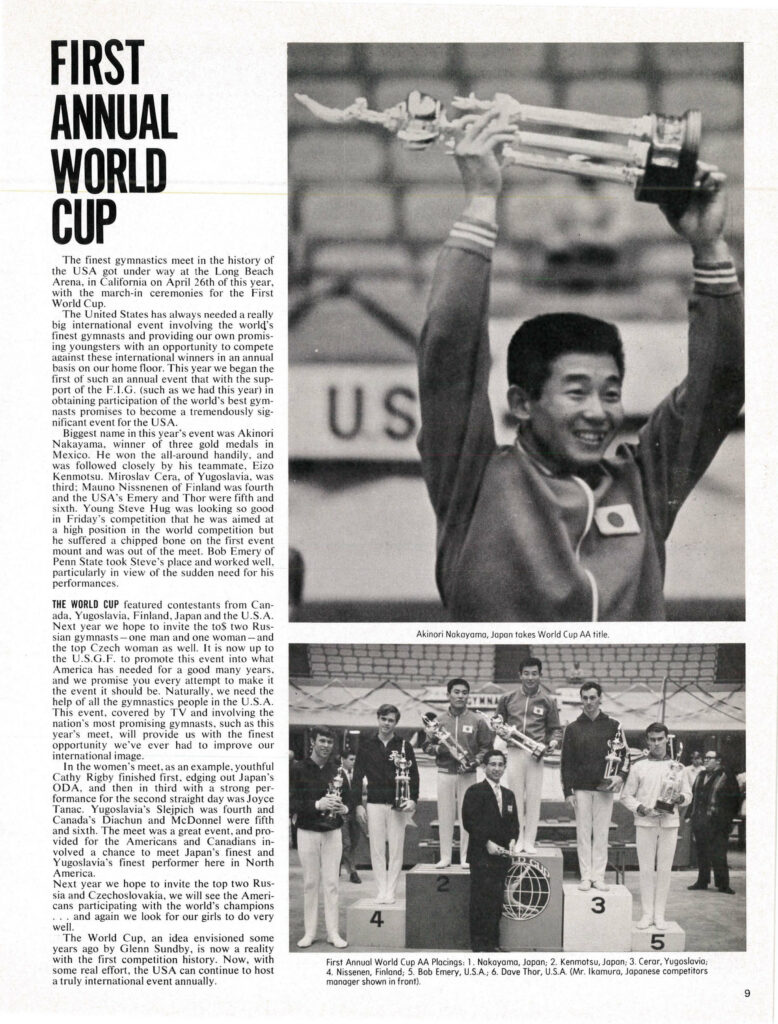
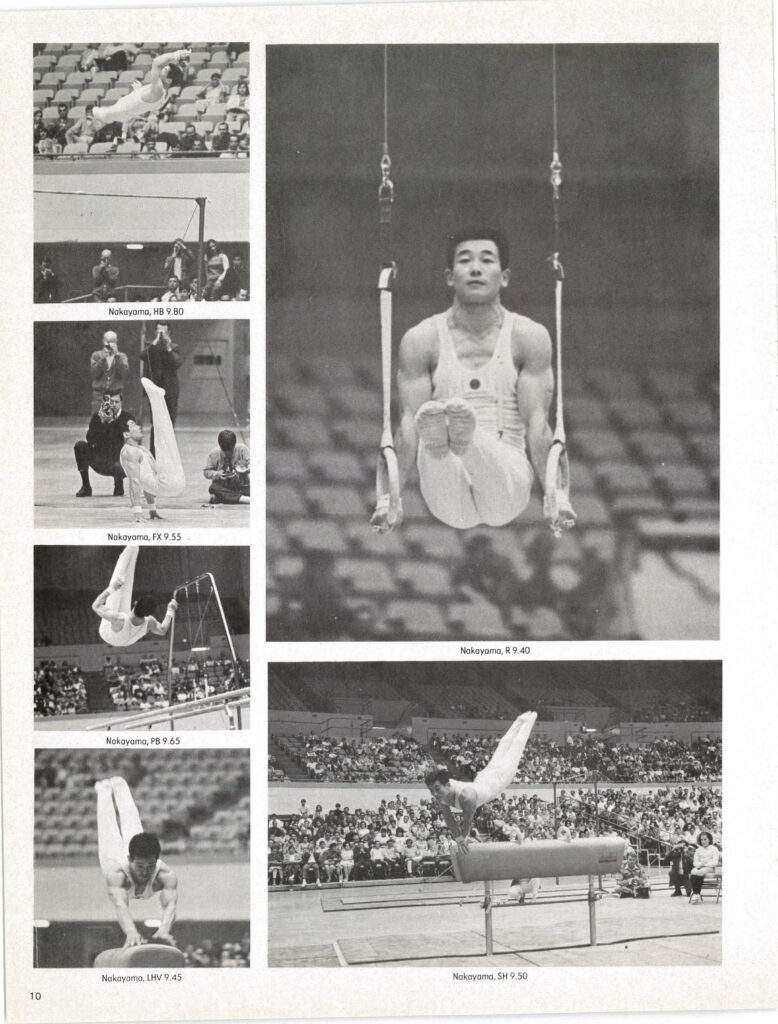
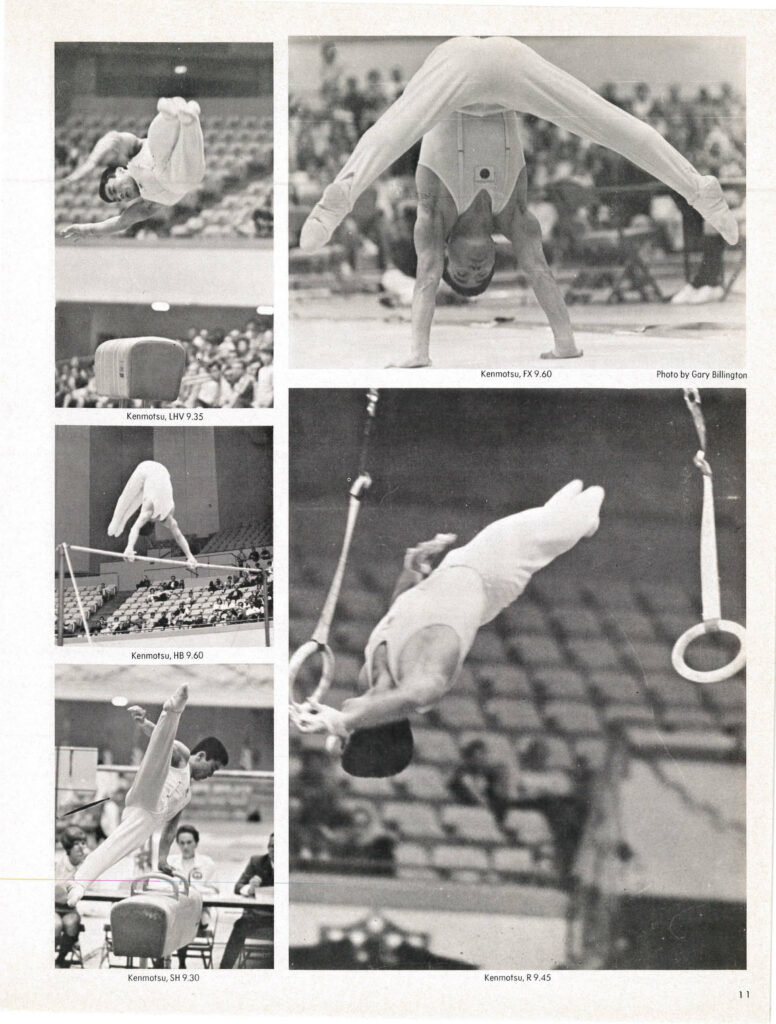
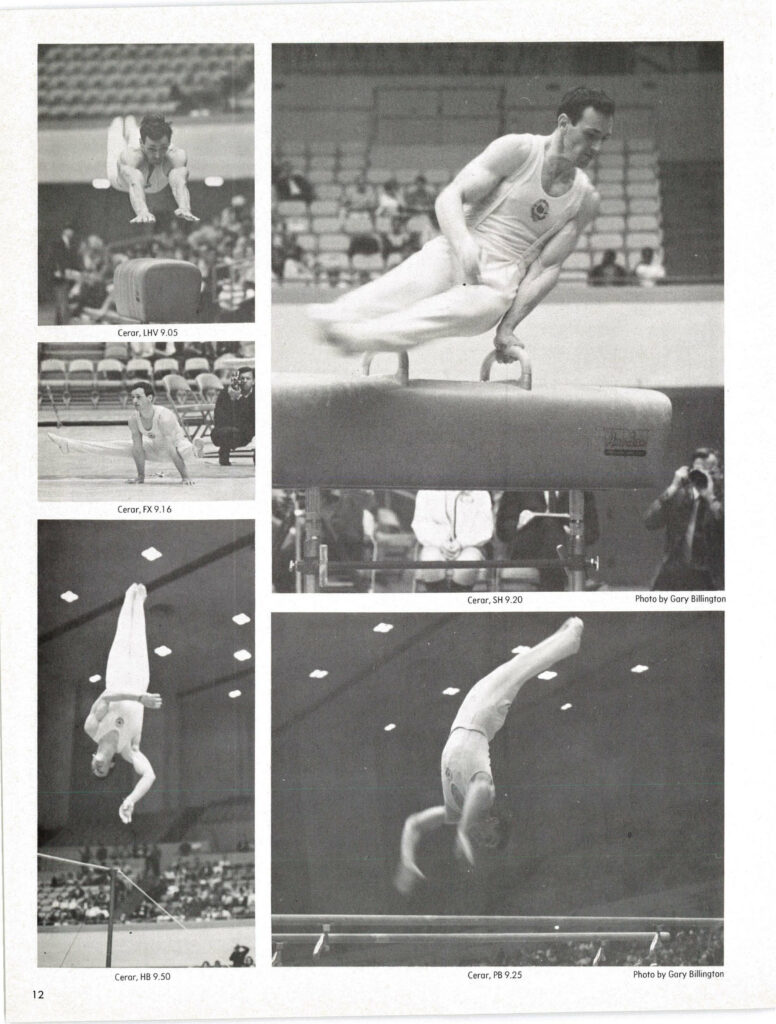
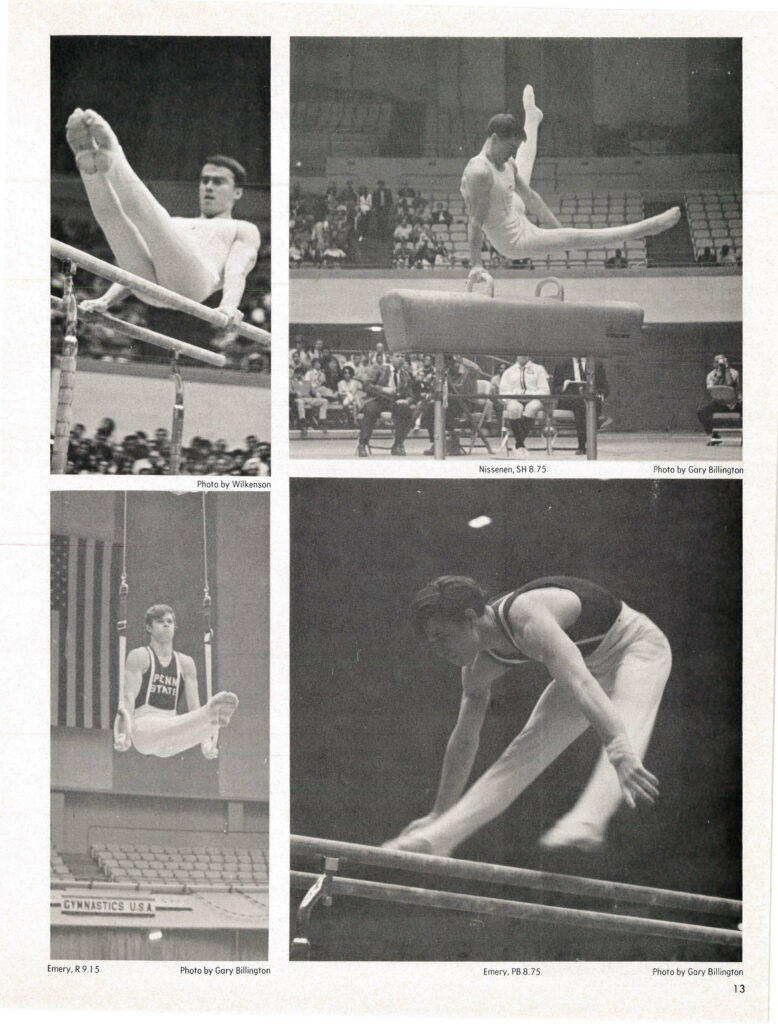
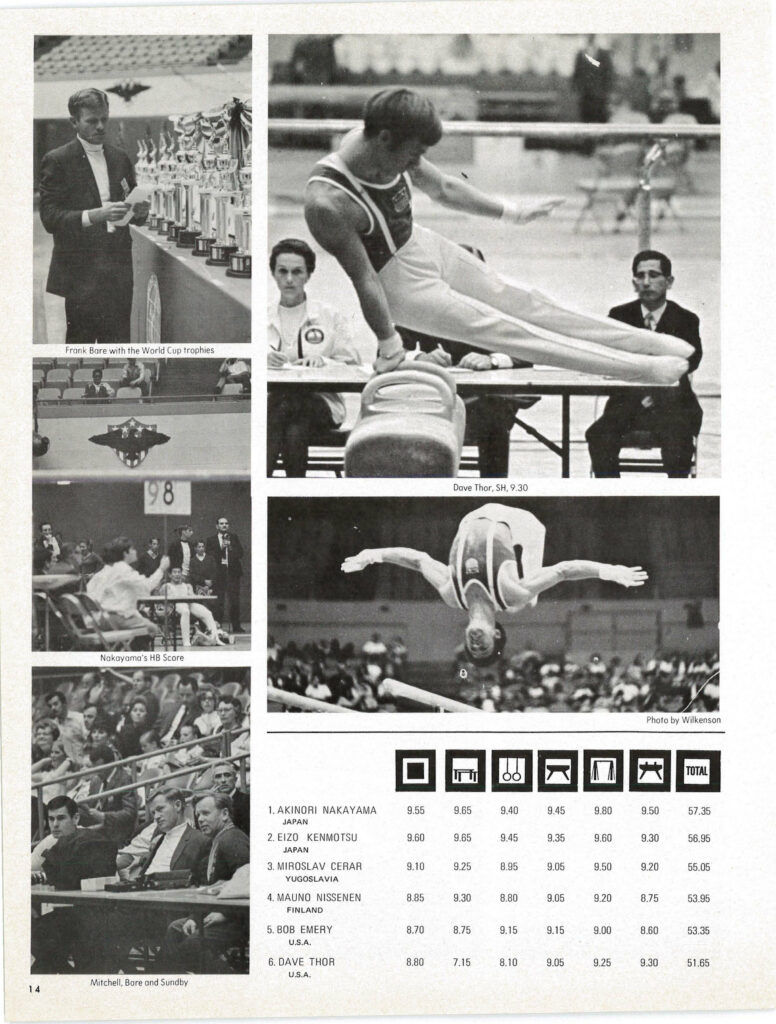
One reply on “1969: The USGF World Cup”
It’s so cool to learn about this. It’s a shame that some of the videos have already been taken down. I can now only wonder what the content of them was.